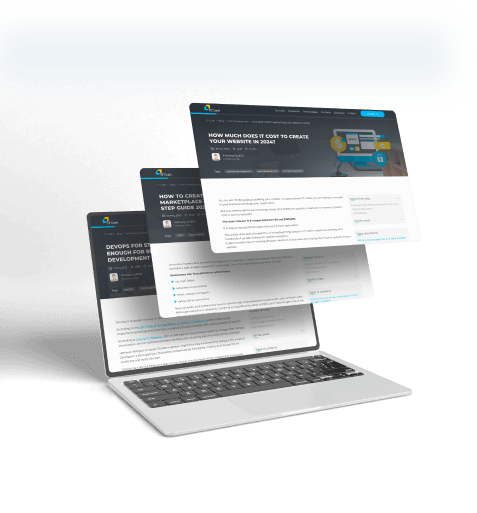Telemedicine has taken center stage. Its professed promises are touted everywhere.
- rendering remote medical help
- providing both patient consultations and case conferences
- issuing and transmitting health information
- sharing treatment methods
Telemedicine apps are continually being ramped up in response to demands for healthcare application development. Modern communication technologies simplify the exchange of medical information. Video, audio, and text messaging eliminate unnecessary steps.
It is not surprising that telemedicine mobile apps appear with increasing frequency, each touting different functionalities.
The market of telehealth solutions is highly segmented by:
- types
- components
- delivery mode
- geography
But delivering a top-notch telemedicine app users want has proven to be both lucrative and challenging for medical startups.
What are the key aspects startup founders need to turn their investment into a stable revenue source? Check them out below.
1 Telemedicine Apps: Why Choose Them for Startup Development at All?
Short answer: growing user interest.
Ideas for providing remote healthcare services are not new. Over a hundred years ago, doctors tried remote healthcare using the telephone and radio. Yet, it seemed unattainable until 2020 with the arrival of the COVID-19 pandemic. Out of necessity, habits changed, popularizing digital telehealth solutions. Apps helped physicians provide many more consultations than office consultations because of necessary safety factors.
Similar to fitness apps, the number of ‘tele’ visits decreased after the mass vaccination. Yet the general trend toward further acceptance of telehealth services remained.
People liked the convenience and accessibility of telehealth services.
The survey conducted by SingleCare showed a high level of user satisfaction with teleconsultations:
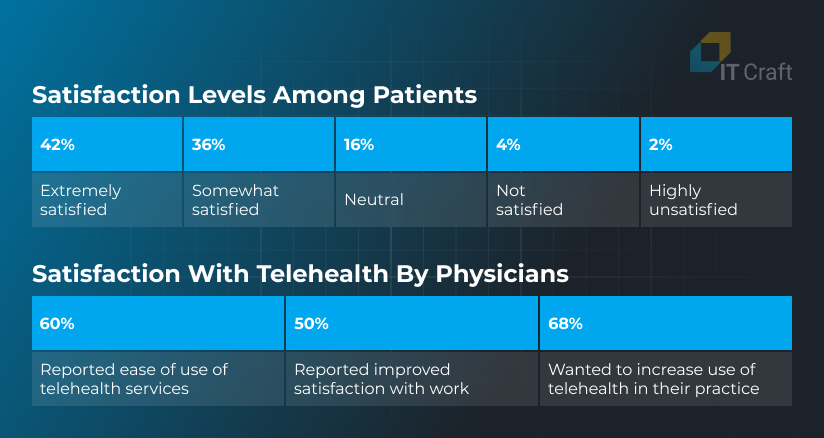 Source: SingleCare
Source: SingleCare
Patients are ready to use telehealth services for common illnesses, follow-up visits, etc., when no specific treatment is required:
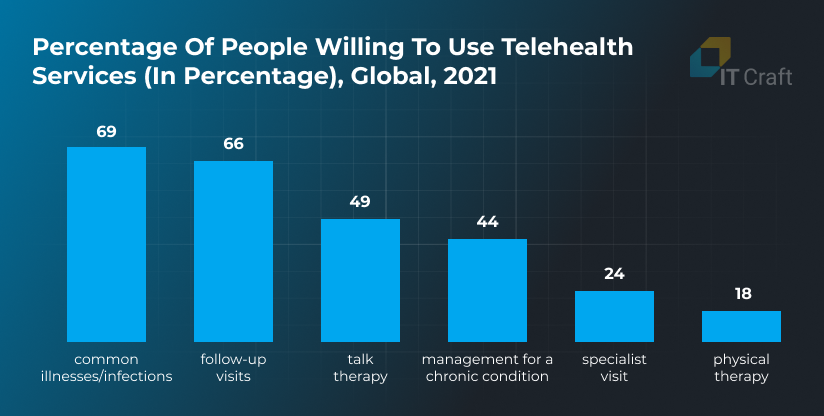 Source: SingleCare
Source: SingleCare
Analysts expect the market to grow rapidly. According to a report by Grand View Research, the global telehealth market is estimated to be $101.15 B in 2023. The projected CAGR is 24%.
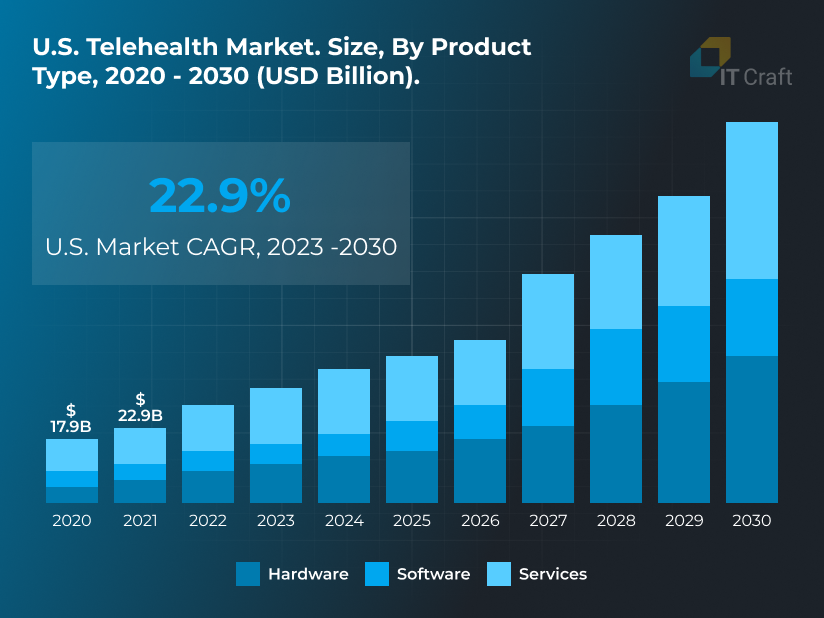 Source: Grandviewresearch
Source: Grandviewresearch
North America remains the principal market for telehealth services, followed by the EU.
Asia Pacific is the fastest-growing market.
 Source: Grandviewresearch
Source: Grandviewresearch
2 Benefits of Telemedicine App Development for End Users
The most valuable basic aspects of telemedicine apps include:
- Better and more efficient medical services.
Telemedicine apps help reduce the spread of diseases and even mortality by improving diagnostics and providing faster treatment.
- Improved communication between doctors from small local hospitals and their peers from clinical centers.
Doctors in villages or small towns keep pace with their professional development due to eliminating information isolation.
- Instant consultations on urgent cases.
When there is no time to arrange an appointment, with the help of “doctor-doctor” telemedicine app development, they consult via a telemedicine mobile app. Doctors can convene a virtual medical board for rare or complex cases.
Benefits of a telemedicine app vary depending on users—doctors or patients, thus two main app types include:
- Doctor to patient
- Doctor to doctor
Benefits for Patients
Patients schedule a virtual visit with a specialist using their smartphone.
- Speed of diagnostic
Through apps for doctors, telemedicine helps medical specialists diagnose and begin treatment faster. Access to patient history and results of remote monitoring increase accuracy.
- No distance barriers
Telemedicine eliminates boundaries. Distance is no longer a critical factor in providing medical care. Using a telemedicine app, patients can receive a fast consultation. The number of kept appointments increases.
Benefits for Doctors
Doctors receive consultations on current cases.
- Expand network of professionals
Through apps for doctors, telemedicine opens opportunities for new, effective collaborations. Interdisciplinary professional communication helps specialists from different medical areas expand their professional backgrounds.
- Knowledge sharing
Apps serve medical consultations and even operations under virtual supervision by a specialist far away.
For example, many surgeons make recordings of rare and complex surgeries in the US, so students and colleagues around the world learn from these cases.
3 Most Common Features of a Telemedicine App
A telemedicine app is always a complex solution:
First, there is more than one application.
Second, even an MVP needs to provide feature-rich functionality.
For the most interesting case — ‘Patient – Doctor’ solution — the development team must install:
- Admin panel for management of the entire system (usually a web-based platform)
- iOS and Android applications for doctors
- iOS and Android applications for patients
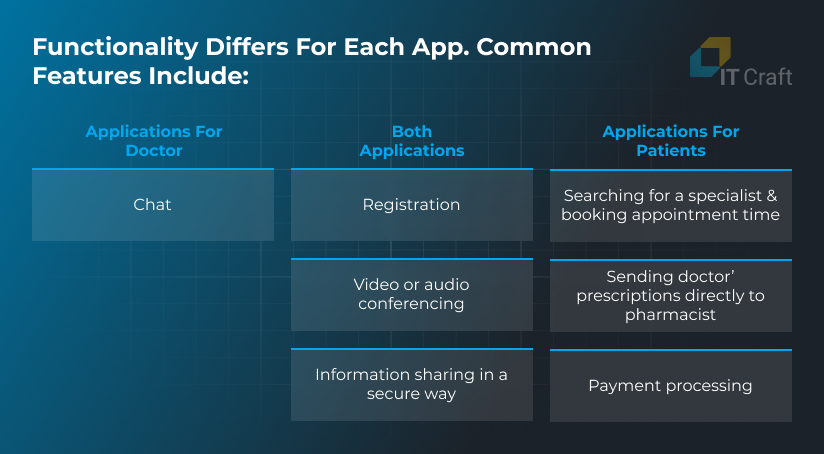
Registration
Registration is obligatory for both telemedicine apps for doctors and solutions for patients. The registration process is the necessary first, basic step for all users.
Patients must be verified. Doctors need to be thoroughly checked to ensure their competence and relevant qualifications.
Search
The searching option lets people find a doctor with the required specialization and schedule a call. Patients make an appointment from their homes in the most transparent manner.
Search
The searching option lets people find a doctor with the required specialization and schedule a call. Patients make an appointment from their homes in the most transparent manner.
Video or audio conferencing
Video communication is a best-for-patient option in every telemedicine app. The one significant downside to video calls: a video-based telemedicine app development solution substantially increases development costs.
Chat
Text messaging is another useful feature. Doctors can use the chat function as a quick reminder for their patients.
Chat helps clarify a remaining concern or question after a video appointment, eliminating any need to schedule a follow-up video call.
Information sharing
Everything must be secure: communication, storing sensitive data, sharing medical records.
Security is possible only when users follow strict rules and implement relevant protocols:
- encrypt all browser-to-server connections using the HTTPS protocol
- sign all requests with a short-lived token for user authentication
- encrypt patient files on the fly
- implement country-specific local safety rules.
Integrations with pharmacies
Sending doctors’ prescriptions directly to pharmacists simplifies the treatment process.
What do the patients do? Just go to the pharmacy and pick up their orders.
Or have it delivered. No additional calls or appointments are necessary. Fast and convenient. If businesses do not integrate this step, they might ruin the entire UX.
Payment processing
Payments are an essential feature of any telemedicine service. There are several ways patients can pay doctors. The most common include:
- Insurance payments
Patients add their insurance information to the system. The system checks whether their insurance covers expenses. If it does, the system notifies the insurance company to pay for certain services.
- Payment by credit/debit card
Patients pay using a credit or debit card if they have no insurance or their insurance does not cover appointment costs. The payment system transfers payment directly to the doctor’s account.
- Hybrid system
Part of a teleconsultation cost is covered under a patient’s insurance plan. The patient pays the rest.
Chatbot
Chatbots serve as a help desk and a simple recommendation system. They can help schedule an appointment with the right specialist by making a preliminary check. Also, they can answer typical questions, saving patients’ and doctors’ time.
4 Technology Stack for a Telehealth App
As already discussed, the development team will use both web and mobile technologies when working on a telehealth app.
The user app can be web or mobile, depending on specific requirements and budget limits.
The administration panel is web based.
The team can choose from various technologies when building a telemedicine app.
A typical tech stack includes:
Front end: CSS | HTML | JavaScript | TypeScript | Angular | React
Mobile: Swift | Objective-C | Kotlin | Java | React Native
Back end: Node.js | Laravel | Symfony | Java | .NET
Databases: Firebase | MySQL | MongoDB | PostgreSQL Redis
Third-party integrations: Elasticsearch | Stripe | PayPal | Chatbot
Security: OAuth2.0 | symmetric and asymmetric data encryption
Deployment: Docker microservices | Auto scaling | Kubernetes | CI | Jenkins
Cloud: AWS | Microsoft Azure
Testing: phpspec | Behat | Karma | Jasmine| JMeter | BrowserStack
Team collaboration: Gitlab | Github | Jira
5 How Much Does it Cost to Develop a Telemedicine App?
Costs of a telemedicine app cover development of an administration panel and dedicated apps. On average, it takes 2,796 working hours to complete core functionality on a telemedicine project.
A development team must integrate 3 – 5 apps into one complex telemedicine solution.
Custom functionality can add extra working hours (i.e., extra development costs) to a project. Also, HIPAA compliance and high-security standards affect the overall telemedicine app price.
Below is the minimum time required to develop a telemedicine solution (multiplied by the average Central/Eastern European hourly rate of $50):
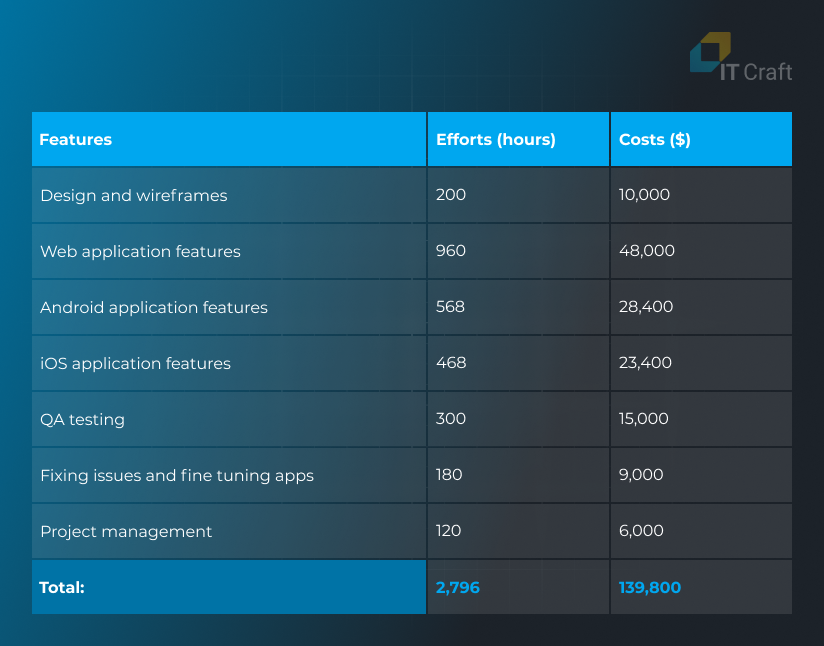
Click here to download a detailed breakdown of costs
Also, add maintenance costs: 10% – 15% from initial development costs per year, $13,900 – $20,970.
We can easily calculate approximate telemedicine app costs by multiplying required working hours and hourly rates around the world:
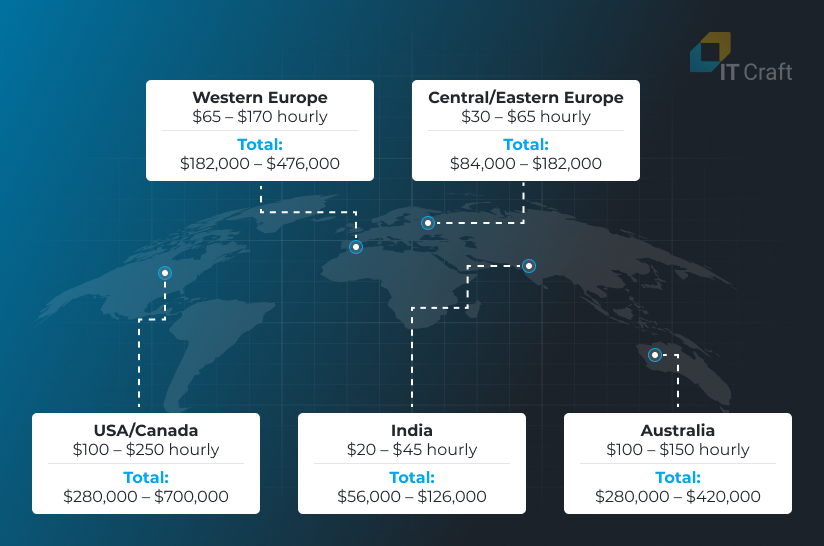
6 How to Develop a Telehealth App
Here are the steps needed to deliver a high-quality telemedicine app:
Project discovery and prototyping
Startups face the challenge of creating an engaging product for a conservative, highly regulated industry. They must factor in a long sales cycle and increasing transition time for turning product pilots into customers.
Prototyping becomes a cost-effective tool for market study.
Startups need to build several prototypes before they move to the next steps.
They use prototypes to study the reaction of end users and industry experts. Their feedback helps improve the initial idea.
MVP development
When there is interest among end users or investors, it makes sense to proceed to MVP development.
An Agile-based approach, such as Scrum, works best for MVP development. Each new portion of functionality is ready within a two-week Sprint, enabling the startup to test it and reevaluate the strategy when required.
Launch and maintenance
When launching a telehealth app in the stores, startups need to ensure correct download permissions are in place, such as availability in only certain regions. Invitation-only policy works for web solutions. A software administrator adds users upon approval.
Startups should not ignore the app after launching. They must keep a maintenance team that monitors system health and provides necessary updates.
Project expansion
Startups should be prepared for user growth. Telehealth apps are resource consuming. Hence, the team must scale them effectively to eliminate glitches, low-quality video calls, or service downtime.
Also, adding new features might present unforeseen challenges. The development team needs to build flexible architecture. It also must focus on automating regression testing to ensure that growing changes do not negatively affect the existing source code.
7 Monetizing a Telemedicine App
Both functionality and monetization are crucial for telemedicine startups to succeed. Check what encourages users to opt for paid services.
The startups might consider the following monetization strategies:
Subscription
Subscription is the best option for startups. Subscription renewals become the source of stable income. Still, startups must provide enough value and build trust to convince users to pay regularly.
Ensure different subscription levels, depending on the volume of consumed services. Also, consider a free trial to encourage users to test your platform.
Freemium
The biggest hurdle to implementing this model: startups should determine correctly which functionality comes at no cost and which is payable. Offering too little functionality discourages users from registering. Providing too many free features decreases revenues. A study might be required to find the perfect balance.
Also, a great offer includes allowing users to adjust services within the app as often as needed. Cancel terms are transparent.
Transaction fees
Transaction fees work well for users who are not ready to subscribe but use the platform occasionally. The platform charges specialists a fraction of the cost patients pay for a video call instead of a regular fee.
The rest of the functionality, such as chat or file sharing, could be available permanently.
White-label solution
Hospitals or healthcare facilities can be interested in this option to provide cost-effective, next-gen services.
On one hand, they customize the platform and use it under their own brand, controlling patient data and treatment process; on the other, they do not need to hire and retain a development team internally.
Sponsorships
Startups could consider offering sponsorship options when working on an on-demand, Uber-like healthcare app. Sponsorships will help doctors and clinics receive visibility on the platform, thus attracting patients looking for higher quality healthcare services or a new provider.
It is possible to combine several monetization models, adjusting them to the needs of different user groups, e.g., subscriptions for small practices and white labeling for large clinics.
8 Challenges of Telemedicine App Development
Before you start building a telemedicine app, consider the challenges you might encounter.
Security. You need to ensure your app is safe for your users. This fact cannot be stressed enough. The security of user data is the essential key for healthcare software development. If you fail here, you face legal consequences.
- Carefully attend to data encryption.
- Provide multi-factor authentication during the implementation phase.
- Comply with regulations. Follow security protocols.
UI/UX. Telemedicine apps target a wide audience, including the elderly. Every step must be intuitive and easy. Spending time and effort on your UI/UX phase is important. The development phase must ensure everything functions well. If users cannot easily understand the UI/UX, the app falls short and might fail.
Remuneration. When you decide on creating a telemedicine app, take payment into account. Payers and system users can be different personas. Ensure everyone understands user roles and payment flow.
Too-narrow focus. When people found local, narrow-focused startups, they might fall short of the required number of paying users to be profitable. The local market may not be enough for successful scaling, blocking growth and access to required funding. It is wise to think through how different markets benefit from your software.
Data ownership. You need to think through whether your solution generates specific data streams. It helps you partner with clinics and find investment. Yet, your startup should work on the data use strategy from day one. Ensure both benefits for the provider and patients. Support top-level protection of patient rights. Make sure there is a transparent policy on collected data, its storage transfer to the interested party, and the option for users to revoke consent at any time.
Payments. Remember, some insurance companies consider remote emergency assistance and related medical care activities as full-time work. They must be reimbursed as regular work at a hospital. You must create a telemedicine app enabling insurance companies to pay doctors or medical facilities.
9 IT Craft Expertise in Medical App Development
XPERTyme
This Web application was once launched as an MVP platform for paid video consultations.
XPERTyme quickly grew in popularity. The team expanded its functionality to cater to the needs of different types of businesses. Consulting companies can use the marketplace functionality or opt for a white-label solution, operating the platform under their own brand.
XPERTyme provides a certified solution for medical professionals — MEDITyme — as a part of its expanded ecosystem.
Doctors can use MEDITyme for telemedicine consultations. Clinics can use MEDITyme as a white-label solution for setting up their own custom internal system.
Different types of calls are available:
- one-to-one and group consultations
- webinars
- on-demand videos
The team implemented enhanced data encryption as part of the certification process.
The platform simplifies administrative work, helping track essential call and payment data.
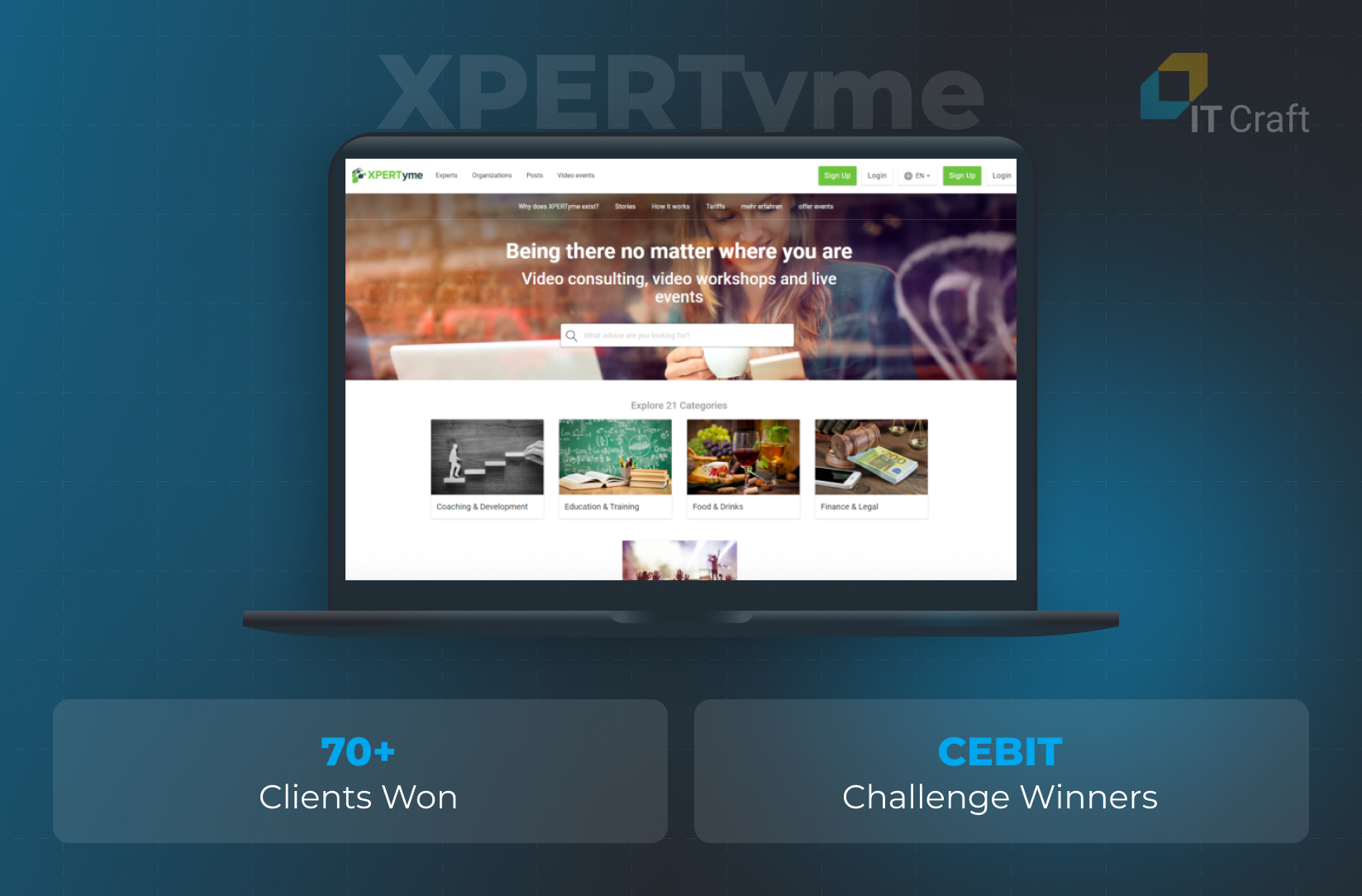
! Closing Thoughts
Telemedicine startups need a solid understanding of stakeholders’ demands and concerns:
- When and where telemedicine services make more sense than in-person visits.
- How market participants save costs.
- For what functionality stakeholders are ready to pay.
Startups must work hard to carve their niche and engage an audience big enough to make profits.
Partnerships with providers of medical services help with validation. Providers are interested in generating data that they can turn into specific insights.
It is equally essential to hire an experienced provider of outsourcing services. Startups save development costs. They delegate safely, knowing the team will abide by strict industry standards.
FAQs
Telemedicine app requires from the startup the following steps:
- Discovery and prototyping
- MVP development, comprising of:
- UI/UX development
- Front-end and mobile development
- Back-end development
- QA and testing
- App launch
- Post-launch maintenance
- App scaling and expansion
Some popular telemedicine apps:
- Amwell
- MDLive
- Doctor On Demand
- Teladoc
- MEDITyme
The costs of telemedicine app development range from $56,000 to $700,000. Cost depends on the complexity of the feature list and the provider’s location.
The most common monetization strategies for telehealth apps include:
- Offering subscription plans.
- Providing premium features (freemium).
- Charging transaction fees.
- Supporting white-label solution.
- Sponsorships
